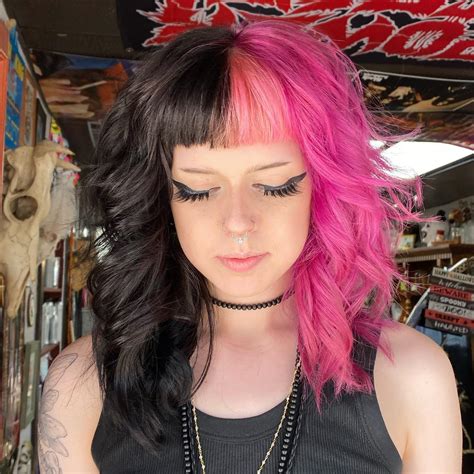Introduction

Split hair dye, also known as half and half hair color, has become a popular trend in the world of hair styling. Experimenting with this unique and edgy look can add a dash of flair and personality to your appearance. This article delves into the realm of split hair dye, providing everything you need to know about this captivating style.
Chapter 1: The Basics of Split Hair Dye
- Definition: Split hair dye involves dividing the hair into two distinct sections and coloring each section in a different hue.
- Types: The two most common types of split hair dye are horizontal (where the division is made across the head) and vertical (where the division is made down the center).
- Benefits: Split hair dye offers a versatile way to express individuality, experiment with bold colors, and frame the face in a flattering way.
Chapter 2: Choosing the Right Colors
- Complementary Colors: Select colors that are opposite each other on the color wheel, such as blue and orange, to create striking contrast.
- Analogous Colors: Opt for colors that are next to each other on the color wheel, such as green and blue, for a more subtle and harmonious effect.
- Personal Preference: Ultimately, the choice of colors comes down to your personal style and preferences. Consider your skin tone, eye color, and wardrobe when making your decision.
Chapter 3: DIY or Salon: Which Is Right for You?
- DIY Split Hair Dye: With proper preparation and caution, it is possible to achieve split hair dye at home. However, it is essential to be patient and follow the instructions carefully to avoid damage.
- Salon Split Hair Dye: For a professional finish, visit a skilled hair stylist who specializes in split hair dye. They can guide you with color selection and ensure precise application.
Chapter 4: Step-by-Step Split Hair Dye Tutorial
- Section Hair: Divide your hair into two equal parts, creating a clean partition.
- Apply Color: Start with one section and apply the chosen color according to the manufacturer’s instructions.
- Wrap and Leave: Secure the hair in place with cling wrap and leave the color in for the recommended time.
- Rinse and Repeat: Rinse out the first color, dry your hair, and then repeat the process for the second color.
- Condition and Style: Once both colors are applied, condition your hair to replenish moisture and style as desired.
Chapter 5: Creative Applications
- Ombre Split: Gradually blend two colors together for a softer transition.
- Hidden Split: Create a hidden split by dyeing only the underside of your hair, revealing the color when it is pulled up.
- Reverse Split: Instead of dividing the hair horizontally or vertically, create a diagonal line for a unique and eye-catching effect.
Chapter 6: Maintaining Split Hair Dye
- Regular Trim: Frequent trims will remove split ends and keep your hair looking healthy.
- Color Refresh: Refresh the color every 4-6 weeks to maintain its vibrancy.
- Use Color-Safe Products: Invest in shampoos and conditioners specifically designed for colored hair to prevent fading.
Chapter 7: Split Hair Dye Statistics and Trends
- According to a recent survey by L’Oréal, over 40% of women aged 18-35 have considered split hair dye.
- Pinterest reports a 120% increase in pins related to split hair dye in the past year.
- Industry analysts predict that the split hair dye trend will continue to grow in popularity due to its versatility and appeal.
Conclusion
Split hair dye presents a captivating way to express your individuality and elevate your style. Whether you opt for a bold contrast or a subtle blend, this trend offers endless possibilities for creativity. By following the steps outlined in this comprehensive guide, you can achieve a flawless split hair dye look that turns heads. Embrace the power of division and conquer the world of hair fashion with this unique and alluring style.
